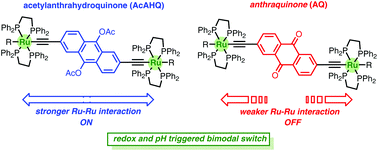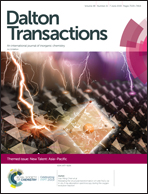Dinuclear ruthenium acetylide complexes with diethynylated anthrahydroquinone and anthraquinone frameworks: a multi-stimuli-responsive organometallic switch†
Abstract
The anthrahydroquinone (AHQ)/anthraquinone (AQ) system is of particular interest as a molecular switching system for molecule-based devices because AHQ and AQ can be interconverted by redox stimuli and their π-conjugated systems are distinct from each other. To date, however, a way to modify and/or functionalize the switching behavior based on the AHQ/AQ system is still limited. In the present contribution, the synthesis and properties of multi-responsive dinuclear molecular switches having Ru(dppe)2 fragments bridged by the diethynylated diacetoxyanthracene (AcAHQ) and AQ units (μ-AcAHQ/AQ){C![[triple bond, length as m-dash]](https://www.rsc.org/images/entities/char_e002.gif) C-Ru(R)(dppe)2}2 (R = Cl, C4TMS) are presented. The terminal Ru(dppe)2 fragments are redox-active and, therefore, the intermetallic interaction can be estimated by electrochemical as well as IVCT band analysis. As a result, the organometallic AcAHQ/AQ-Ru system turns out to be an effective bimodal molecular switch, which is triggered not only by redox stimuli but also by pH stimuli.
C-Ru(R)(dppe)2}2 (R = Cl, C4TMS) are presented. The terminal Ru(dppe)2 fragments are redox-active and, therefore, the intermetallic interaction can be estimated by electrochemical as well as IVCT band analysis. As a result, the organometallic AcAHQ/AQ-Ru system turns out to be an effective bimodal molecular switch, which is triggered not only by redox stimuli but also by pH stimuli.

- This article is part of the themed collection: New Talent: Asia-Pacific


 Please wait while we load your content...
Please wait while we load your content...